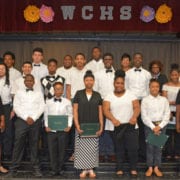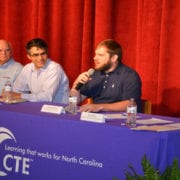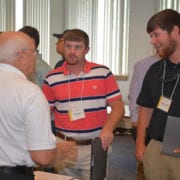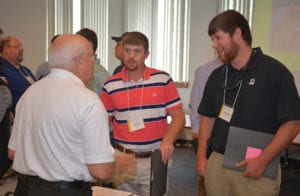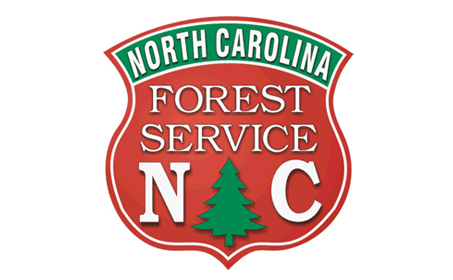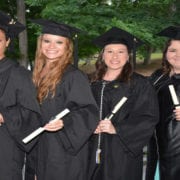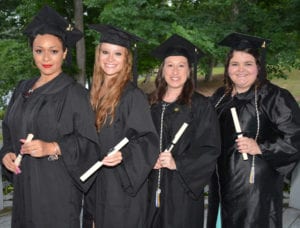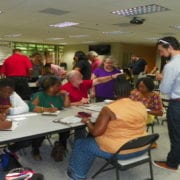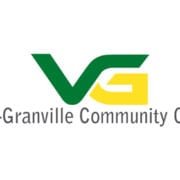Warren County students graduate from VGCC summer transportation institute
Nineteen Warren County High School students were recently honored for graduating from the National Summer Transportation Institute (NSTI), hosted by Vance-Granville Community College’s Warren County Campus. This was the second consecutive year that the institute was offered, in addition to a similar Summer Transportation & Trades Academy held on the campus in 2015.
The three-week summer program was conducted by the college in partnership with Warren County Schools, the North Carolina Department of Transportation and the Federal Highway Administration. The NSTI concluded on June 30, when graduation exercises were held at Warren County High School.
Graduates included WCHS students Jahmad Attucks, Timothy Batchelor, Daniel Braswell, Juan Cervantes, Timothy Edwards, Destiny Hightower, Domilig’e Hunter, Leonte Jiggetts, Dustin Jordan, Quantaya Marion, Zacchaeus Marrow, Nathan Milam, Tavis Mills, RocQuan Perry, James Robinson, Diamond Shaw, Jakayla Simes, Rhasheed Wheeler and Montellus Williams.
Three graduates were recognized with outstanding achievement awards for going “above and beyond”: Attucks, Hightower and Simes.
The ceremony, entitled “Transformation through Transportation III,” began with welcoming remarks by VGCC Warren County Campus Dean Lyndon Hall, who oversaw the NSTI grant project for the college, and Vice President of Academic Affairs Dr. Angela Ballentine. Last year, VGCC became the first community college in North Carolina to host a camp through an NSTI grant, under the leadership of recently-retired VGCC Director of Occupational Extension Jean Blaine.
The staff for the camp included coordinator Odessa Perry and assistant coordinator Leslie Dundas, both Warren County educators; and academic aide Peter Marcellas Robinson of Creedmoor, a graduate of the VGCC Electronics Engineering Technology program.
During the graduation ceremony, groups of students made presentations that summarized their experiences during the program, which focused on Science, Technology, Engineering and Math (STEM) as well as “soft skills” and exploring careers in transportation by land, air and water.
The camp featured a variety of guest presenters. As they learned about workplace safety, students became certified in CPR and first aid by Stephen Barney from the VGCC Emergency Medical Services department. Among the other VGCC faculty and staff teaching sessions were Assistant Director of Financial Aid Jeremy Lambert, Librarian Jennie Davis, Academic Skills Center Coordinator Jason Snelling, College Success & Study Skills Program Head Olu Ariyo and Warren Campus Coordinator/Instructor of Basic Skills Edna Scott.
Students went on several field trips during the program, visiting the Battleship North Carolina in Wilmington, Hatteras Yacht Manufacturing, Amtrak stations in Durham and Raleigh, and the Carolina Sunrock facility in Butner.
Leigh Dennis, a Certified Equipment Manager (CEM) and manager of fleet services for Carolina Sunrock, was the guest speaker for the graduation ceremony. “What our graduates have accomplished both individually and as a team is impressive,” Dennis said. “It also has great value to them and the transportation industry.”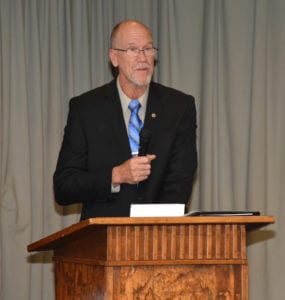 He told the graduates, “In this program, you have met and surmounted the challenges presented to you by your instructors. You have traveled to see and experience some transportation industries at work and, in the process, been introduced to some of the vast opportunity that awaits. With the higher education programs and career paths available in the field of transportation, we are all hopeful that you will keep our industries in mind when deciding what you want to do.”
He told the graduates, “In this program, you have met and surmounted the challenges presented to you by your instructors. You have traveled to see and experience some transportation industries at work and, in the process, been introduced to some of the vast opportunity that awaits. With the higher education programs and career paths available in the field of transportation, we are all hopeful that you will keep our industries in mind when deciding what you want to do.”
Dennis said that he had been professionally involved with the construction of transportation infrastructure (earthmoving, road-building, utilities installation and materials production) for 35 years. But even he learned something new when he visited the NSTI camp in Warrenton. “I had told some of my team where I was going that day so when I returned to work, some of them asked jokingly, ‘So, did you learn anything at school today?’ As a matter of fact, I did, I said, at which point I showed them pictures of what you were doing – learning and applying the concept of LED circuitry to arrange a circuit board to first make the lights come on and then program them to blink in succession,” he recalled.
“No one in the room was joking any more. People that have worked in the materials production and delivery part of the transportation industry for years were using words such as ‘incredible’ and ‘amazing’ to describe what they were seeing in the pictures. Activities like this prove that you have been tested in ways that help you see and apply the values of teamwork, collaboration and cooperation,” Dennis said. “When you combine that with field trips to see transportation at work in the real world, you now own what we in the business world refer to as ‘invaluable experience.’ This is a powerful term which, by the way, looks really good on college or employment applications and resumes.” He concluded by saying, “Graduates of the 2017 National Summer Transportation Institute, as a long-time member and representative of the transportation industry, I salute you and wish you well on your journeys to success.”
Also on hand to congratulate the graduates were Federal Highway Administration Civil Rights Program Manager Lynise DeVance, N.C. Department of Transportation Education Initiatives Coordinator JoAna McCoy, and VGCC Vice President of Student Services Dr. Levy Brown.
Each participant attended the camp at no cost and received a stipend based upon their attendance and active participation in camp activities.
VGCC is partnering with the DOT on a number of training initiatives, including a Heavy Equipment Operator course, which is also conducted at the Warren Campus. For more information on that program, contact Lyndon Hall at halll@vgcc.edu or (252) 738-3687.

